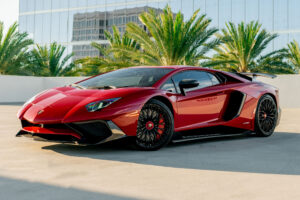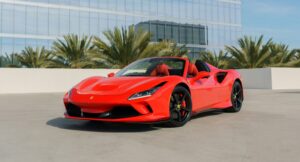McLaren holds a prominent place in the annals of automotive and racing history. The story of this illustrious brand began with the vision of its founder, Bruce McLaren, who hailed from Auckland, New Zealand.
His journey in motorsports started at a tender age when he initially tinkered with an old Austin 7 as a young schoolboy. Bruce’s determination and passion for racing translated into formidable success on the track, which eventually sowed the seeds for the creation of the McLaren Racing team.
Established in 1963, Bruce McLaren’s foray into building his racing team was driven by an unwavering pursuit of excellence. Under his leadership, McLaren quickly emerged as a force to be reckoned with in the competitive arena of Formula One. The team distinguished itself through a series of victories and innovations that have left a lasting impact on the racing world.
The company expanded from its racing roots to become a significant manufacturer of high-performance sports cars. McLaren has made a notable mark on both track and street, building on a legacy of technological innovation and transferring processes and materials from Formula One to road cars. This dual commitment to performance and innovation remains a cornerstone of the McLaren ethos.
Founding and Early Years
The history of McLaren is a tale of ingenuity and ambition, beginning with a young New Zealander’s passion for motor racing and evolving into a renowned global entity in high-performance sports cars and Formula One.
Bruce McLaren’s Origins
Bruce McLaren was born in Auckland, New Zealand, in 1937. He displayed a strong passion and talent for engineering and motor racing from an early age. His formative years saw him rebuild an Austin 7 and compete in local racing events. His determination and skill quickly became apparent, and by the age of 22, Bruce had secured a historic win at the United States Grand Prix in Sebring, Florida, driving for Cooper Cars. McLaren’s early success was a mere hint of what would come as his lifelong journey in racing unfolded.
Formation of Bruce McLaren Motor Racing
In 1963, Bruce McLaren founded Bruce McLaren Motor Racing in London, marking the start of what would become a legendary name in motor racing. As a founder, driver, and engineer, McLaren shaped the team’s ethos and technical direction. His establishment of the team was driven by the desire to innovate within the world of motor racing. Quickly gaining momentum, the team soon became a formidable force in the industry, combining Bruce McLaren’s driving prowess with his acute engineering insights.
Rise to Prominence in Motorsport
McLaren’s ascendancy to the peaks of motorsport is a story of innovation, dominance, and legendary figures. Their legacy in racing disciplines like Can-Am and Formula 1 has been shaped by groundbreaking vehicles and some of the sport’s most renowned drivers.
Can-Am Domination
In the late 1960s and early 1970s, McLaren became a force to be reckoned with in the Canadian American Challenge Cup, commonly known as Can-Am. Their McLaren F1 cars, with their powerful engines and advanced aerodynamics, secured five consecutive titles from 1967 to 1971. This era was dominated by Bruce McLaren’s and Denny Hulme’s exceptional driving skills, which left competitors such as Ferrari trailing in their wake.
Formula 1 Milestones
McLaren’s trajectory in Formula 1 has been marked by numerous milestones that cemented its status as a top constructor. Their first Grand Prix victory came in 1968, and since then, they have accrued an impressive tally of wins and championships. The McLaren F1 team became synonymous with success using technological innovations, such as the carbon fiber monocoque, which revolutionized car design and provided a competitive edge.
McLaren’s Iconic Drivers
McLaren has a storied history of iconic drivers contributing to its rise. Emerson Fittipaldi, James Hunt, Niki Lauda, Alain Prost, Ayrton Senna, John Watson, and Lewis Hamilton are just a few of the elite who have driven for the team. Senna and Prost formed one of the most compelling rivalries in F1 history, pushing each other to new heights and securing multiple championships. Their time at McLaren is still celebrated as one of the most exhilarating periods in racing history.
Expansion and Diversification
Throughout its history, McLaren has continuously pushed the envelope in automotive excellence and performance. The brand’s foray into high-performance sports cars and storied success in motorsports illustrate its unyielding pursuit of innovation and excellence.
McLaren Automotive Marvels
McLaren Automotive emerged as an independent supercar manufacturer, embarking on an expansion that built upon its racing heritage. The company’s production covers a range of technologically advanced sports cars that sit squarely at the intersection of luxury and performance.
The highlight of this transition from track to road includes notable models like the McLaren P1, which falls into the pinnacle category of supercars and represents a leap in engineering and technology. The P1, part of the ultimate series, showcased the brand’s devotion to creating road cars that draw upon their Le Mans and Formula 1 experience.
- Key Models:
- McLaren P1
- McLaren Speedtail
- McLaren Artura
- McLaren 650S
Supercar Innovation
Innovation is at the core of McLaren’s DNA, often illustrated by their groundbreaking approach to supercar design and technology. The McLaren F1 set a world record as the fastest production car, and McLaren continued to build on this with models like the Speedtail—a hyper-GT and McLaren’s current fastest model with a top speed of 250 mph.
Their consistent drive for innovation is also seen in the Artura, representing a new hybrid supercar age. Blending performance with environmental consideration, the Artura stands as a testament to modern engineering advancements.
- Innovation Examples:
- F1’s fastest production car record
- Speedtail’s top speed of 250 mph
- Artura’s hybrid technology
Racing vs. Road Cars
McLaren’s prowess is not limited to the racetrack. While McLaren Racing solidified its legacy with indelible Ford and TAG-Porsche engined victories, the road car division, based in Woking, England, extends this excellence to public roads.
Their competence in producing some of the world’s most extraordinary road-going vehicles demonstrates a successful technology transfer from racing to production.
The collaboration with Mercedes-Benz in producing the McLaren GT and the brand’s persistent pursuit of creating versatile sports cars that cater to both thrill and practicality, like the McLaren 650S, reaffirm the company’s commitment to compete at the highest level of supercar manufacturing.
- Key Partnerships:
- McLaren and Ford
- TAG-Porsche collaboration
- Mercedes-Benz and McLaren GT co-production
Legacy and Future Outlook
McLaren’s storied past is interwoven with cutting-edge technology and a formidable presence in global motorsports, shaping a future that promises continued innovation and performance.
Technological Advancements
McLaren has consistently been at the forefront of technological innovation in the automotive industry. Its introduction of the McLaren F1 in the 1990s revolutionized the supercar realm with its carbon-fibre chassis and unmatched speed.
- Notable Innovations:
- Carbon-fibre chassis
- Active aerodynamics
- Brake steer
In the 21st century, McLaren launched models like the MP4-12C and 720S, which epitomized the combination of lightweight construction and powerful, efficient engines.
The company’s collaboration with partners such as Honda has also led to advancements in hybrid technologies, which are showcased in models like the P1 and the Speedtail.
Global Motorsports Impact
Since McLaren’s inception, its contributions to motorsports have been significant and numerous. Teddy Mayer’s leadership, drivers like Bruce McLaren, Mark Donohue, and Johnny Rutherford, and the innovative designs of Gordon Murray have carved out a legacy in racing that continues to influence the industry.
- Motorsports Milestones:
- First victory at the Monaco Grand Prix
- Multiple wins at Formula 1 Constructor Championships
- Success in the Can-Am series and at the 24 Hours of Le Mans
McLaren Group’s presence in locations such as Goodwood and across the UK underscores England’s critical role in global motorsport history, where McLaren continues to be a recurring highlight.
The Next Generation of McLarens
McLaren Automotive looks to the future with an unwavering commitment to pushing boundaries.
The upcoming electric successor to the P1 indicates a shift towards sustainable high performance. Prototypes like the McLaren Elva showcase a continued emphasis on experiential driving and advanced aerodynamics.
- Future Aspects:
- Electric and hybrid technology
- Enhanced driving dynamics
- Expanding the supercar spectrum
Models like the 675LT and the 570S, with their attention to detail and performance, indicate where McLaren aims to take the supercar market.
Pole positions and victories in Formula 1 remain a benchmark for the company’s ongoing pursuit of automotive excellence.

